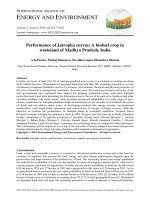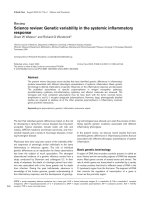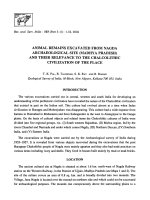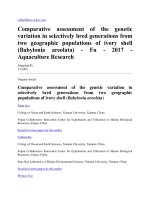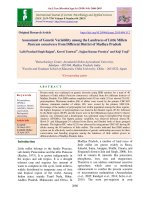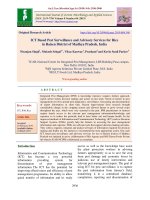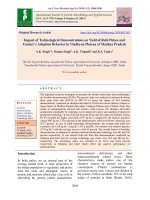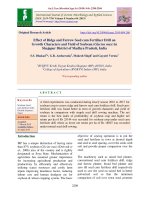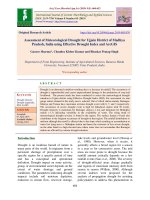Assessment of genetic variability among the landraces of little millets Panicum sumatrense from different district of Madhya Pradesh
Bạn đang xem bản rút gọn của tài liệu. Xem và tải ngay bản đầy đủ của tài liệu tại đây (294.36 KB, 8 trang )
Int.J.Curr.Microbiol.App.Sci (2019) 8(4): 2686-2693
International Journal of Current Microbiology and Applied Sciences
ISSN: 2319-7706 Volume 8 Number 04 (2019)
Journal homepage:
Original Research Article
/>
Assessment of Genetic Variability among the Landraces of Little Millets
Panicum sumatrense from Different District of Madhya Pradesh
Lalit Prashad Singh Rajput1, Keerti Tantwai1*, Sajjan Kumar Pooniya1 and Koji Tsuji2
1
Biotechnology Centre, Jawaharlal Nehru Agricultural University,
Jabalpur - 482 004, Madhya Pradesh, India
2
Faculty and Graduate School of Education, Chiba University, Chiba – 263-8522, Japan
*Corresponding author
ABSTRACT
Keywords
Polymorphism,
UPGMA,
Landraces, Genetic
variability, Genetic
conservation,
Phylogenetic
relationship
Article Info
Accepted:
20 March 2019
Available Online:
10 April 2019
Present study was conducted on genetic diversity using ISSR markers for a total of 40
landraces of little millet (Panicum sumatrense) collected from five different districts of
Madhya Pradesh. Ten ISSR markers amplified total 42 loci while 32 loci showed 76.19%
polymorphism. Maximum number (06) of alleles were scored by the primers UBC-807
whereas, minimum number of alleles (03) were scored by the primers UBC-816.
Percentage of the number of polymorphic loci within population among the three regions,
the highest frequency of polymorphism was found in the Dindori region (97.61) followed
by the Betul region (80.95) and the lowest were in the Chhindwara region (40.47). Cluster
analysis was estimated and a dendrogram was generated using Unweighted Pair Group
Analysis (UPGMA). The highest genetic variability was observed between Amwa-38,
Shivri-31 and Khaparipani-24 collected from Rewa and Dindori both of them grouped
distantly. The highest PIC value (0.53) was observed by using primer UBC-853 having 06
alleles among the 40 landraces of little millets. The results indicated that ISSR marker
system can be effectively used in determination of genetic relationship necessary for their
conservation and breeding programs among the landraces of little millets grown in
different districts of Madhya Pradesh, India.
Introduction
Little millet belongs to the family Poaceae,
sub-family Panicoideae and the tribe Paniceae
(Rachie, 1975). It is grown indigenously in
the tropics and sub tropics. It is a drought
tolerant crop and requires less amount of
water to complete its life cycle. Little millet is
widely distributed in temperate zone of Asia
and tropical region of the world. Among
Indian states, mainly Tamil Nadu, Bihar,
Andhra Pradesh, Maharastra and Orrisa. In
Madhya Pradesh, a number of land races of
little millet are grown widely in Rewa,
Sahadol, Satna, Anuppur, Shidhi, Umaria, and
Singarauli district (Jain and Singh, 2008). It is
rich in vitamin B, minerals like potassium,
phosphorus, iron, zinc and magnesium.
Therefore it can address nutritional sensitive
agriculture, which aims at nutritional
enhancement to combat the present scenario
of micronutrient malnutrition (Arunachalam
et al., 2005; Kundgol et al., 2014; Selvi et al.,
2015). The most pre-requisite in crop
2686
Int.J.Curr.Microbiol.App.Sci (2019) 8(4): 2686-2693
breeding is, exploitation of genetic variability
existing in the crop for yield and related traits.
Various DNA-based markers systems have
been applied to several plants groups for
delimiting clones and to assess their level of
genetic diversity. Molecular markers have
been proven to be use for crop improvement
and evaluation of genetic resources (Mohan et
al., 1997). PCR-based molecular markers are
widely used in many plant species for
identification,
phylogenetic
analyses,
population studies and genetic linkage
mapping (Williams et al., 1990). The ISSR
analysis is a very useful molecular tool for
studying population genetics on a wide range
of plant species, as well as for identifying
species, cultivars, or population of the same
species (Zietkiewicz et al., 1994 and Wang et
al., 2009). The present study was aimed to
explore genetic variability in little millet
landraces. The information on genetic
variability and component analysis can be of
great help in formulating appropriate breeding
strategy for genetic upgradation of little
millets. The present study was undertaken
with the objective to analyze the genetic
variability among the landraces of little millet
through ISSR marker.
Materials and Methods
Plant materials
Forty landraces of little millet were collected
from five different geographical regions of
Madhya Pradesh. Plants were grown in
polyhouse and collected the fresh young leaf
samples for isolation of genomic DNA.
DNA extraction
DNA was isolated from young leaves of little
millet using CTAB Protocol (Saghai-Maroof
et al., 1984) with some modifications.
Chemical used for the extraction of DNA
were 100mM Tris-HCl (pH 8.0), 20mM
EDTA (pH 8.0), 0.5M NaCl, 2% CTAB
(Cetyl Trimethyl-Ammonium Bromide), 0.2%
β-mercaptoethanol,
2.5%
PVP
(Polyvinylpyrrolidone),
24:1Chloroformisoamyl alcohol (IAA), 3M sodium acetate
(pH4.8), Isopropanol (-20ºC), 70% ethanol,
5M NaCl. DNA quality was tested by (0.8%)
agarose gel electrophoresis and visualized
under UV light.
PCR analysis
The PCR amplification procedure for
amplification of DNA components and their
concentration used in the ISSR. PCR reaction
was prepared as described in Table 2. PCR
amplification reactions volume of 20μl
consisting 2μl of PCR buffer 1X, 2.4μl of
MgCl2 2.5mM, 0.2μl of Tag Polymerase
(5Unit/μl) 0.5μl of dNTPs10mM, 2μl of
Primer 10pM, 2μl of genomic DNA 50ng and
nuclease free water was used to make up the
total volume 20μl. Amplifications were
performed using “BIORAD T100 and Agilent
Technologies
Sure
Cycler
8800”
programmable thermal cycler with the cycling
parameters that was programmed for ISSR
with an initial denaturation step at 94°C for 4
min followed by 45 cycles at 94°C for 45
second, 50°C for 1 min annealing and 72°C
for 2 min elongation. In the final cycle, the
elongation step at 72°C was extended by 5
min
Statistical data analysis
PCR product using ISSR primers were scored
on the agarose gel as presence (1) or absence
(0) of bands of molecular weight size in the
form of binary matrix for the entire sample
studied. The frequency of a null allele at a
given locus was estimated by taking the
square root of the frequency of null
homozygosity (the absence of a band), which
assumes that there are two alleles at a locus
under Hardy-Weinberg equilibrium. Based on
2687
Int.J.Curr.Microbiol.App.Sci (2019) 8(4): 2686-2693
the estimated frequency of a null allele,
frequency of heterozygosity (H) within
population (Hs) and all individuals (Ht) were
calculated. The genetic differentiation among
populations (Gst) was calculated as (Ht average Hs)/Ht (Nei 1973). Data were
analyzed to obtain Jaccard’s coefficients
among the isolates by using NTSYS-PC
Version 2.02e software (Rohlf, 1998).
Polymorphic information content (PIC)
values were calculated for each ISSR primer
according to the formula: PIC = 1 - R (Pij) 2,
where Pij is the frequency of the ith pattern
revealed by the jth primer summed across all
patterns revealed by the primers (Botstein et
al., 1980). A dendrogram was constructed
using UPGMA (Unweighted Pair-Group
Method with Arithmetic Averages) with the
SAHN
(Sequential,
Agglomerative,
Hierarchical, and Nested Clustering) routine.
Results and Discussion
The marker analysis helps to understand the
genetic makeup of the germplasm and also
make it possible to analyze genetic diversity
within species as well as between species. In
the present study 40 land races of little millets
(Table 1) were used for ISSR analysis with 10
random primers (Table 3) which gave
scorable DNA bands and each of the 10
random primers revealed polymorphism
(Table 4).
The primers produced high degree of
polymorphism with an average of 76.19%.
Average 4.2 bands per primer were amplified.
Among the 10 primers two primers viz. UBC834
and
UBC-853
revealed
100%
polymorphism.
The
percentage
of
polymorphism across the landraces of little
millet ranged from 60–100%. Polymorphism
Information Content (PIC) was estimated for
each of the 10 ISSR markers. Higher value of
PIC score indicated higher polymorphism of
the ISSR markers and therefore helped in
selecting the best ISSR marker in
phylogenetic analysis. The Highest PIC value
(0.53) was observed for UBC-853 which has
04 alleles among the 40 landraces of little
millets. Markers UBC834, UBC-807 also had
high PIC scores with high number of alleles.
Lowest PIC value (0.37) was obtained from
UBC-816. Percentage of the number of
polymorphic loci within population among
the three regions, the highest frequency of
polymorphism was found in the Dindori
region (97.61) followed by the Betul region
(80.95) and the lowest were in the
Chhindwara region (40.47). Polymorphism
was also detected within each region (Table
5). The results also showed that the Dindori
region had the highest Hs among the four
regions (0.35), while the Hs of the Betul
region was 0.34 and Chhindwara region was
0.14. Rewa Ht was 0.25 and Gst on these four
geographic regions was 0.20. Percentage of
the number of polymorphic loci within region
was the highest in the Dindori region
(97.61%, n=22), second was in the Betul
region (80.95%, n=4), and the third was Rewa
region (76.19%, n=6), lowest was in
Chhindwara region (40.47%, n=4). The
cluster analysis was carried out based on PCR
amplification banding pattern of ISSR
primers, pair wise genetic similarity among
40 landraces of little millet. A dendrogram
was generated using Unweighted Pair Group
Analysis (UPGMA) in “NTSYS-pc version
2.02e” programme (Fig. 1).
Phylogenetic relationships the Dindori region
formed a genetically distinct group based on
their genetic distance from the individuals in
the Chhindwara, Betul, and Rewa region. The
highest genetic diversity was observed in
Dindori region.
The results indicated that ISSR markers have
been successfully utilized for assessing the
genetic diversity and revealed a remarkable
molecular discrimination between the 40
landraces of little millet.
2688
Int.J.Curr.Microbiol.App.Sci (2019) 8(4): 2686-2693
Table.1 List of collected landraces of little millet
SN
1
2
3
4
5
6
7
8
9
10
11
12
13
14
15
16
17
18
19
20
21
22
23
24
25
26
27
28
29
30
31
32
33
34
35
36
37
38
39
40
Name of accessions
REWKUT20171125-4
REWKUT20171125-6
REWKUT20171126-1
REWKUT20171126-3
REWKUT20171126-5
REWKUT20171126-6
CHHKUT20171127-2
CHHKUT20171127-4
CHHKUT20171127-9
CHHKUT20171127-11
BETKUT20171128-2
BETKUT20171128-4
BETKUT20171128-5
BETKUT20171128-7
DINKUT20160830-1
DINKUT20160830-2
DINKUT20160830-3
DINKUT20160830-4
DINKUT20160830-5
DINKUT20160830-6
DINKUT20160830-7
DINKUT20160830-8
DINKUT20160830-9
DINKUT20160830-10
DINKUT20160830-11
DINKUT20160830-12
DINKUT20180219-1
DINKUT20180219-2
DINKUT20180219-3
DINKUT20180315-1
DINKUT20180315-2
DINKUT20180315-3
DINKUT20180315-4
DINKUT20180315-5
DINKUT20180315-6
JABKUT20180315-7
20171125Weedy
REKUT20171125-8
CHHIKUT20171127-12
BETKUT20171128-4
Collection site
Amwa-1
Amwa-2
Pokhra-3
Pokhra-4
Charhai-5
Charhai-6
Pipariya-7
Pipariya-8
Ghugarlakalan-9
Ghugarlakalan-10
Lahas-11
Lahas-12
Khamla-13
Khamla-14
Shivri-15
Shivri-16
Shivri-17
Shivri-18
Shivri-19
Sherajhar-20
Sherajhar-21
Khaparipani-22
Khaparipani-23
Khaparipani-24
Khaparipani-25
Khaparipani-26
Fadki-27
Aunrai-28
Padariya-29
Shivri-30
Shivri-31
Shivri-32
Shivri-33
Shivri-34
Dindori-35
Kundam-36
Rewa-37
Amwa-38
Ghugarlakalan-39
Khamla-40
2689
Geographical location
Latitude
Longitude
N 34, 48, 19
E 82, 21, 54
N 34, 48, 19
E 82, 21, 54
N 34, 48, 19
E 82, 21, 54
N 22, 3, 26
E 78, 56, 17
N 22, 3, 26
E 78, 56, 17
N 21, 54, 4
E 77, 53, 45
District
Rewa
Chhindwara
Betul
N 21, 54, 4
E 77, 53, 45
N 22, 50, 35
E 81, 14, 57
Dindori
N 22, 35, 17
E 81, 19, 16
Dindori
N 22, 39, 20
E81, 16, 41
Dindori
N 22, 59, 59
N 22 56, 36
N 22, 3, 26
E 80, 57, 28
E 81, 4, 37
E 78, 56, 17
N 22, 50, 35
E 81, 14, 57
N 22, 56, 36
N 23, 13, 7
E 81, 4, 38
E 80, 21, 3
N 34, 48, 19
N 22, 3, 26
N 21, 54, 4
E 82, 21, 54
E 78, 56, 17
E 77, 53, 45
Dindori
Dindori
Dindori
Dindori
Dindori
Janalpur
Rewa
Chhindwara
Betul
Int.J.Curr.Microbiol.App.Sci (2019) 8(4): 2686-2693
Table.2 PCR components with their concentrations used for PCR reaction
Sl.
1.
2.
3.
4.
5.
6.
7.
Components
10X PCR buffer
25mM MgCl2
10mM dNTPs
Primer
Tag Polymerase (5 Unit/μl)
Nuclease free H2O
DNA
Concentrations
1x
2.5mM
200µM
10pM
1 unit
For volume making
50ng
Volume
2.0μl
2.4μl
0.5μl
2.0μl
0.2μl
10.9μl
2.0μl
Table.3 List of ISSR primer and their sequence
S. No.
1
2
3
4
5
6
7
8
9
10
Primer Code
UBC-834
UBC-807
UBC-841
UBC- 853
UBC-845
UBC-812
UBC-816
UBC-825
UBC-884
UBC-886
Primer Sequence 5'-3'
5'-AGAGAGAGAGAGAGAGYT-3'
5'-AGAGAGAGAGAGAGAGT-3'
5'-GAGAGAGAGAGAGAGAC-3'
5'-TCT CTC TCT CTC TCT CRT-3'
5'-CTC TCT CTC TCT CTC TRG-3'
5'-GAG AGA GAG AGA GAG AA-3'
5'-CAC ACA CAC ACA CAC AT-3'
5'-ACA CAC ACA CAC ACA CT-3'
5'-HBH AGA GAG AGA GAG AG-3'
5'-VDV CTC TCT CTC TCT CT-3'
Table.4 Polymorphism Information Content (PIC) value of using ISSR markers among 40
landraces of little millet
SN
1
2
3
4
5
6
7
8
9
10
Total
Primer
UBC-834
UBC-807
UBC-841
UBC-853
UBC-872
UBC-812
UBC-816
UBC-825
UBC-884
UBC-886
No. of
allele
Monomorphic
band
Polymorphic
band
% of
polymorphism
4
7
5
4
5
4
3
4
4
4
42
0
1
2
0
1
2
1
1
1
1
10
4
6
3
4
4
2
2
3
3
3
100
85.71
60
100
80
50
66.66
75
75
75
2690
Polymorphism
Information
Content (PIC)
0.51
0.48
0.42
0.53
0.41
0.39
0.37
0.38
0.41
0.45
Int.J.Curr.Microbiol.App.Sci (2019) 8(4): 2686-2693
Table.5 Genetic diversity within region
SN
1
2
3
4
5
Region
Rewa
Chhindwara
Betul
Dindori
All locations
Number of
populations
Number of
individuals
4
2
2
5
13
10
4
4
22
40
Number of
polymorphic
loci within
region
32
17
34
41
32
% of
polymorphic
loci within
region
76.19
40.47
80.95
97.61
76.91
Hs or
Ht
Gst
0.25
0.14
0.34
0.35
0.34
0.20
Fig.1 Dendrogram on the basis of the ISSR marker similarity matrix data by Unweighted Pair
Group Method with Average (UPGMA) cluster analysis among 40 landraces of little millet
The ISSR analysis revealed the information
on genetic variability and component analysis
can be of great help in formulating
appropriate breeding strategy for genetic
relationship of among the landraces of little
millets. In present investigation collected 40
landraces of P. sumatrense selected from
various district of Madhya Pradesh viz.
Dindori, Chhindwara, Betul, Rewa. The
genetic diversity investigation different
millets genera was undertaken with Inter
Simple Sequence Repeats (ISSR) markers
high level of genetic variability among and
within the different genera Dvorakova et al.,
(2015). M’Ribu and Hilu (1994) additionally
gathered three accessions for P. sumatrense
starting with India and other Panicum sp.
from different Asian nations without any
confirmation of a closer relationship amongst
these 26 accessions utilizing molecular
2691
Int.J.Curr.Microbiol.App.Sci (2019) 8(4): 2686-2693
markers, and morphologically variable (De
Wet et al., 1983, Reddy et al., 1984) which is
reflected by the high genetic diversity
resolved by the RAPD analysis. Similarly, in
present investigation, the 32 genotypes of P.
sumatrense obtained from the region of India
and evaluated genetic diversity by using out
of 36 RAPD markers, high variations and
100% polymorphism among all genotypes.
Molecular diversity in 7 landraces of little
millet has been reported however it was also
observed that the all landraces are genetically
uniform and any observed diversity could be
due to environmental variation Arunachalam
et al., (2005). For this study, 40 landraces for
P. sumatrense diverse districts for India with
identify polymorphism utilizing ISSR marker.
Assessment of genetic variability among
different landraces of little millet indicated
the efficiency of ISSR markers in
investigation genetic variability at molecular
level and identification of desirable
germplasm and its utilization for further
breeding program. Such information may be
useful for selecting the diverse parents and
monitoring the genetic diversity periodically
for improvement of little millets.
References
Arunachalam, V., Rengalakshmi, R., and
Kubera-Raj, M, S. 2005. Ecological
stability of genetic diversity among
landraces of little millet (Panicum
sumatrense) in south India. Genetic
Resources and Crop Evolution. 52, 1519.
Botstein, D., White, RL., Skolnick, M., and
Davis RW. 1980. Construction of a
genetic linkage map in man using
restriction
fragment
length
polymorphisms. American Journal of
Human Gene 32, 314–331.
Dvorakovaa, Z., Cepkovaa, PH., Janovskab,
D., Viehmannovaa, L., Svobodovaa,
E., Cusimamania, EF., and Milellac L.
2015. Comparative analysis of genetic
diversity of 8 millet genera revealed
by ISSR markers. Emirates Journal of
food and agriculture 8: 617-628.
Jain, A., K. and Singh R, P. 2008. A profile
on
project
report:
Collection,
maintenance, characterization and
evaluation of land races of Small
millets especially for biotic stresses in
the tribal areas of Rewa division of
Madhya
Pradesh.
College
of
Agriculture, Rewa (M.P.) JNKVV,
Jabalpur (M.P.) 8-9.
Kundgol, N., G, Kasturiba, B., Math, K., K,
and Kamatar M, Y. 2014. Kasturiba
B, Math KK, Kamatar MY. Screening
of little millet landraces for chemical
composition. International Journal of
Farm Sciences. 4, 33-38.
Mohan, M., Nair, S., Bhagwat, A., Krishna,
T., G, Yano, M., Bhatia, C., R, and
Sasak T. 1997. Genome mapping,
molecular markers and markerassisted selection in crop plants.
Molecular Breeding 3, 87-103.
Nei, M., 1973. Analysis of gene diversity in
subdivided populations. Proceedings
of the National Academy of Sciences.
USA, 70, 3321-3323.
Rachie, KO. 1975. The millets Importance,
utilization and outlook. Int. Crops Res.
Inst. Semi-Arid Tropics (ICRISAT
publication) Hyderabad, India.
Rohlf, FJ., 1988. NTSYS-PC numerical
taxonomy and multivariate analysis
system,
version
1.50.
Exeter
Publication, Setauket, New York.
Saghai-Maroof, MA.,
Soliman, KM.,
Jorgensen, RA., and Allard RW. 1984.
Ribosomal DNA spacer length
polymorphism in barley: Mendelian
Inheritance, chromosomal location
and population dynamics. Proceedings
of the National Academy of Sciences
USA 81, 8014-8018.
2692
Int.J.Curr.Microbiol.App.Sci (2019) 8(4): 2686-2693
Selvi, M., V, Nirmalakumari, A., and Senthil
N. 2015. Genetic diversity for zinc,
calcium and iron content of selected
little Millet Genotypes. Journal of
Nutrition & Food Sciences. 5, 1-6.
Wang, HZ., Wu, ZX., Lu, JJ., Shi, NN., Zhao,
Y., Zhang, ZT., and Liu JJ. 2009.
Molecular diversity and relationships
among Cymbidium goeringii cultivars
based on inter-simple sequence repeat
(ISSR) markers. Genetica 136:391–
399.
Williams, JG., Kubelik, AR., Livak, KJ.,
Rafalski, AT., and Ingey SV. 1990.
DNA polymorphisms amplified by
arbitrary primers are useful as genetic
markers. Nucleic Acids Research 18,
6531–6535.
Zietkiewicz, E., Rafalski, A., and Labuda D.
1994. Genome fingerprinting by
simple sequence repeat (SSR)anchored polymerase chain reaction
amplification. Genomics 20,176–183.
How to cite this article:
Lalit Prashad Singh Rajput, Keerti Tantwai, Sajjan Kumar Pooniya and Koji Tsuji. 2019.
Assessment of Genetic Variability among the Landraces of Little Millets Panicum sumatrense
from Different District of Madhya Pradesh. Int.J.Curr.Microbiol.App.Sci. 8(04): 2686-2693.
doi: />
2693
